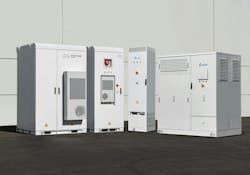What is an ESS? How Ground Handlers Can Benefit from Energy Storage Systems
An Energy Storage System (ESS) is a system of battery storage devices which are used to reserve energy for future use. In essence, it is a large reserve power system that is used to save energy when it is not in demand to supplement insufficient power in times of high demand.
As a permanent or temporary solution, Energy Storage Systems can be used to meet electrification goals in a timely fashion. Energy Storage Solutions are a modular solution with a broad range of capacity—anywhere from 250KWh to 4MWh. When the energy demand changes, Energy Storage Systems are able to add more storage or remove and redistribute excess power storage to other units.
While Energy Storage Systems are larger scale devices with sizes and weights that make them non-mobile, they are not grounded. An Energy Storage System can be relocated to other sites when business needs demand it. The Energy Storage System can be used to electrify an area, then moved to a second high demand area once the infrastructure of the first area catches up to the current needs. It can be used as a temporary solution to start electrification process in advance of or in lieu of infrastructure availability.
Energy Storage Systems primarily convert energy to DC for storage, before reconverting it to AC to send it back through the grid for usage at a later time. The process has a 93-96 percent efficiency. It is also possible to use DC to DC charging directly from Energy Storage System to chargers to raise the efficiency rate and decrease the reliance of grid availability for energy usage.
Most commonly in the recent years, Energy Storage System’s use lithium batteries for energy storage. Almost 90 percent of grid sized Energy Storage Systems in use today utilize lithium battery chemistries. This is due to lithium’s greater power efficiency averaging around 95 percent. Lithium-ion also has a good energy density and longer cycle life. This makes lithium-ion technology well suited for large scale reserve energy solutions.
One of the best applications of Energy Storage Systems is usage in tandem with renewable energy generation. Energy Storage Systems can pull power from multiple sources, reserving power generated from a renewable energy source and supplementing that limited supply by pulling from the grid as well when needed. Using an Energy Storage System in tandem with a renewable energy source mitigates the limiting need for the immediate usage of any most generated energy. This allows for renewable energy sources with generation limitations (such as solar energy’s need for certain weather conditions) to be used more strategically. Rather than generating energy and needing to either immediately use it or sell it back to the utility company, with an Energy Storage System the end user is able to save and utilize that power themselves.
Energy Storage Systems are a solution to the widespread infrastructure issues that inhibit airport electrification. Using Energy Storage Systems, it becomes possible to electrify airports or terminals that do not have the infrastructure to support expansion and do not have the resources to begin a larger scale infrastructure project.
Through the use of an Energy Storage System’s own internal microgrid, an Energy Storage System can store power from the grid or renewable source and run DC to DC power directly to chargers in places that are not currently outfitted with proper electrical infrastructure.
Airports with insufficient power allowances from their utility companies or governing bureaucratic institutions can reserve power from their low usage times for periods of peak energy usage. This process is known as peak shaving and has multiple benefits.
For the purposes of electric fleet expansion and other electrification goals, an Energy Storage System can use reserved energy to bolster the peak energy rate beyond any limited availability. This can allow for expanded electric fleets and charging during peak hours.
If there is no need for further electrification, an Energy Storage System’s peak shaving features can have a significant return on investment. Instead of artificially raising the cap for energy usage, the supplemental energy can lower the peak draw rate seen by the utility. Depending on the utility payment structure, lowering the peak draw rate can have significant financial benefits for the buyer. This is also potentially beneficial to the utility power distribution system, as peak shaving can minimize the chance of the system becoming overloaded during peak periods.
There is also the benefit of added resilience. Energy Storage Systems can be used in the occasion of a black out or brown out to keep the necessary functions running until grid power can be restored. In addition, it can be used to standardize the amount of power being supplied by the utility. Normal grid supply fluctuates as power supply changes. An Energy Storage System can be used to create a steady influx of power by reactively kicking into use when the supply fluctuates lower than the desired level. This keeps the power supply at a consistent rate and allows for chargers and electric equipment to always have the amount of energy needed.
To pursue an Energy Storage System, investigate financial opportunities regarding electrification incentives. Most places have significant tax returns or financial incentives regarding electrification which can be used for the Energy Storage System, whether that is on the local, state or federal level. This can make an Energy Storage System project much more cost effective and feasible.
The process towards getting an Energy Storage System must include extensive power studies to ensure that the system would be a sustainable solution for the specific application.
It is important to understand the energy needs of the site to understand what energy capacity is needed. The Energy Storage System must have enough capacity to fulfill the required usage during peak periods. There also must be enough non-peak availability to refill the Energy Storage System during non-peak periods. If the usage during peak periods requires a capacity that can not be met during non-peak periods, an Energy Storage System would not be the correct solution for that application.
Finally, the local regulations surrounding reserve power and battery storage will need to be checked before the installation of an Energy Storage System. The site location may have size and safety regulations regarding battery storage technology. These regulations may be a hurdle to installing an Energy Storage System.
Energy Storage Systems are a rapidly growing solution to an infrastructure issue that spans this industry and beyond. As renewable energy systems and sustainability goals continue to develop, Energy Storage Systems continue to be seen as a great way to reserve power within an infrastructure that is not reliable.
About the Author

Rebecca Schnack
Application Engineer
Rebecca Schnack is an application engineer with Allen Energy, a company specializing in battery solutions for a GSE application.
